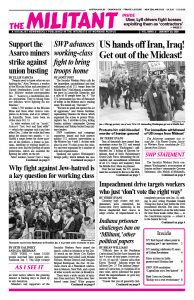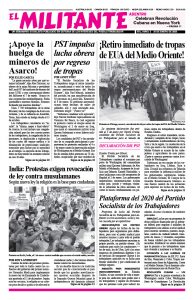NEW YORK — On Dec. 3 the Gothamist, an internet news site run by New York Public Radio, published an article with the headline, “‘These Videos Shouldn’t Exist’: Hours of Old NYPD Surveillance Films of Protests Have Been Digitized.”
The article refers to more than 2,000 videos filmed by the New York City Police Department’s Red Squad between 1960 and 1980 as part of its spy operations against political and union groups and social struggles. Over the past year the city government has posted the newly digitized videos — some 140 hours worth — to its Municipal Archives website for anyone to access, with no agreement from those who were spied on.
By posting the videos — the city calls them “fascinating glimpses of the recent past” — the archives is glossing over the real story, the Red Squad’s targeting of hundreds of groups and individuals on the pretext that they were “potential security threats.” And the city’s political police’s primary goal was not to “monitor,” but to disrupt.
The Gothamist notes that the massive surveillance took place before newer spying devices like police “body cams, or LinkNYC kiosks or fake cellphone towers” existed. Today’s city political police have available feeds from at least 9,000 surveillance cameras in the city.
Among the Red Squad’s targets during those two decades: the Socialist Workers Party, Communist Party, Malcolm X, Black rights groups, women’s rights groups, supporters of independence for Puerto Rico, prisoners’ rights groups, Fidel Castro and Che Guevara. Other targets included the International Ladies’ Garment Workers Union, the Seafarers International Union, opponents of the U.S. war in Vietnam and Irish Republican supporters.
In 1973 the SWP filed a federal lawsuit against the FBI and other government agencies for decades of spying, burglaries, wiretaps, use of undercover informers and disruption, including a counterintelligence program that specially targeted the SWP, under Democratic and Republican administrations alike. The party helped organize the Political Rights Defense Fund, which carried out a broad political campaign to back the suit and expose and push back the government’s anti-working-class domestic political police operations.
In the course of the nearly 15-year fight, the party brought to light that the FBI had gathered more than 30,000 days of wiretaps or “bugs” between 1943 and 1963, carried out at least 208 burglaries of SWP offices and members’ homes, and stole or photographed nearly 10,000 documents. And from 1960 to 1976 alone, the government used 1,300 informants inside and outside the party.
Cops disrupt workers’ movement
This was not simply an information “gathering” operation. The FBI used the information to get SWP members evicted from their apartments and fired from jobs. It wrote “poison pen” letters full of vitriol and lies aimed at creating divisions within the party and with groups the party worked with in the Black movement and other struggles. And it did the same to numerous other groups.
While the political police tactics succeeded in disrupting and breaking many organizations, it failed miserably on the Socialist Workers Party. That’s because of the party’s program and integrity. Party members openly and proudly defend their communist program. They say the same thing in private that they say in public. The party is part of the working-class vanguard, not a sect trying to impose a schema on workers and farmers.
That’s why despite years of spying the FBI could not find one illegal act committed by the party, while the FBI itself had committed thousands of illegal acts in efforts to smear and disrupt the SWP.
In 1986 Judge Thomas Griesa ruled in favor of the party. He found that the its constitutional rights had been violated. He awarded the party over $650,000 in damages and attorneys fees. And the party fought for and won an injunction that not only said the FBI’s files could no longer be accessed by the government but also protected the privacy rights of those names in them.
The party’s lawsuit and political fight was at the cutting edge of battles in a number of cities, including New York, to curtail cop red squad spy and disruption operations.
More than a million spy files
In New York in 1971 victims of city police spying, harassment and disruption activities brought a class-action lawsuit against the Red Squad, known as the Handschu case, named after one of the plaintiffs. The Red Squad had maintained files on more than 1 million individuals and organizations! A similar lawsuit was filed in Chicago in 1975.
But agreements reached in those lawsuits undercut the fight against the political police instead of advancing it.
In New York, despite a challenge from the Socialist Workers Party and other victims of the political police, the court imposed a settlement — backed by the New York Civil Liberties Union and some other liberal groups — pretending to reel in the Red Squad.
But in reality the settlement gives the cops the right to investigate any group it says is “engaged in, about to engage in or has threatened to engage in conduct which constitutes a crime.” And to hang on to the spy files they gathered. The newly digitized videos are just one part of those files. All supposedly monitored by an “independent” three-person board — composed of one “civilian” and two police commissioners! Business as usual with a little extra red tape.
The New York Red Squad has been around since 1904, when it was called the Italian and then the Anarchist Squad. It has gone through many name changes since then. Today the NYPD has at least two red squads — the Intelligence Bureau and the Counterterrorism Bureau. As the class struggle in the U.S. heats up, working-class fighters should be under no illusions. The political police have not gone away.


